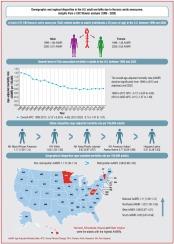美国成人胸主动脉瘤相关死亡率的人口统计学和地区差异:来自CDC WONDER分析的见解(1999-2020)。
IF 2.2
3区 医学
Q2 CARDIAC & CARDIOVASCULAR SYSTEMS
引用次数: 0
摘要
背景:胸主动脉的动脉瘤变性,被称为胸主动脉瘤,是全球死亡率负担的重要因素。尽管医疗保健取得了进步,但胸主动脉瘤相关死亡率的差异继续影响着美国不同的人口和区域群体。目的:调查1999年至2020年美国成人胸主动脉瘤相关死亡率的趋势和差异,重点分析人口统计学(性别、种族和年龄组)、时间和地理(人口普查地区、城市化和州)领域。方法:我们分析了来自疾病控制和预防中心广泛的流行病学研究在线数据(CDC WONDER)数据库(1999-2020)的死亡证明数据,重点关注年龄≥25岁的个体。使用连接点回归分析计算了每10万人的年龄调整死亡率和年百分比变化以及95%置信区间。结果:从1999年到2020年,美国共发生47136例胸主动脉瘤相关死亡,总体年龄调整死亡率为1.01 / 10万人。年龄调整死亡率趋势显示,从1999年到2012年显著下降(年变化百分比为-5.31),随后从2012年到2020年趋于稳定(年变化百分比为-0.15)。性别、种族和人口普查区域之间存在差异,男性、非西班牙裔黑人和居住在中西部的个人显示出更高的年龄调整死亡率。农村地区的年龄调整死亡率略高于城市地区,尽管两者都随着时间的推移而下降。结论:本研究强调了美国胸主动脉瘤相关死亡的持续负担,揭示了不同人口群体和地区死亡率的显著差异。研究结果强调,迫切需要有针对性的公共卫生干预措施来解决这些差异,并改善所有人群的胸主动脉瘤相关结果。本文章由计算机程序翻译,如有差异,请以英文原文为准。

Demographic and regional disparities in adult thoracic aortic aneurysm-related mortality rates in the USA: Insights from a CDC WONDER analysis (1999–2020)
Background
Aneurysmal degenerations of the thoracic aorta, known as thoracic aortic aneurysms, significantly contribute to the global mortality burden. Despite progress in medical care, disparities in thoracic aortic aneurysm-related mortality rates continue to affect various demographic and regional groups in the USA.
Aims
To investigate trends and disparities in thoracic aortic aneurysm-related mortality rates among adults in the USA from 1999 to 2020, with a focused analysis across demographic (sex, ethnicity and age group), temporal and geographical (census region, urbanization and state) domains.
Methods
We analysed death certificate data from the Centers for Disease Control and Prevention Wide-Ranging OnLine Data for Epidemiologic Research (CDC WONDER) database (1999–2020), with a focus on individuals aged ≥ 25 years. Age-adjusted mortality rates per 100,000 and annual percent changes, along with 95% confidence intervals, were calculated using joinpoint regression analysis.
Results
From 1999 to 2020, a total of 47,136 thoracic aortic aneurysm-related deaths occurred in the USA, with an overall age-adjusted mortality rate of 1.01 per 100,000 individuals. Age-adjusted mortality rate trends revealed a significant decline from 1999 to 2012 (annual percent change −5.31), followed by stabilization from 2012 to 2020 (annual percent change −0.15). Disparities were observed across sex, ethnicity and census regions, with males, non-Hispanic Blacks and individuals residing in the Midwest showing higher age-adjusted mortality rates. Rural areas exhibited slightly higher age-adjusted mortality rates than urban areas, although both showed a decline over time.
Conclusions
This study underscores the persistent burden of thoracic aortic aneurysm-related deaths in the USA, revealing notable disparities in mortality rates across various demographic groups and regions. The results highlight the critical need for targeted public health interventions to address these disparities, and to improve thoracic aortic aneurysm-related outcomes for all population segments.
求助全文
通过发布文献求助,成功后即可免费获取论文全文。
去求助
来源期刊

Archives of Cardiovascular Diseases
医学-心血管系统
CiteScore
4.40
自引率
6.70%
发文量
87
审稿时长
34 days
期刊介绍:
The Journal publishes original peer-reviewed clinical and research articles, epidemiological studies, new methodological clinical approaches, review articles and editorials. Topics covered include coronary artery and valve diseases, interventional and pediatric cardiology, cardiovascular surgery, cardiomyopathy and heart failure, arrhythmias and stimulation, cardiovascular imaging, vascular medicine and hypertension, epidemiology and risk factors, and large multicenter studies. Archives of Cardiovascular Diseases also publishes abstracts of papers presented at the annual sessions of the Journées Européennes de la Société Française de Cardiologie and the guidelines edited by the French Society of Cardiology.
 求助内容:
求助内容: 应助结果提醒方式:
应助结果提醒方式:


